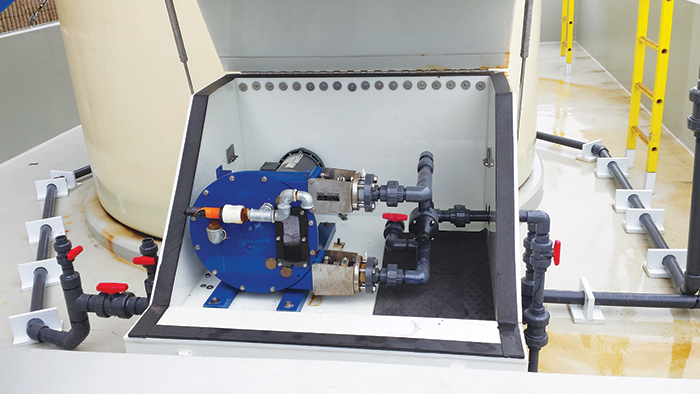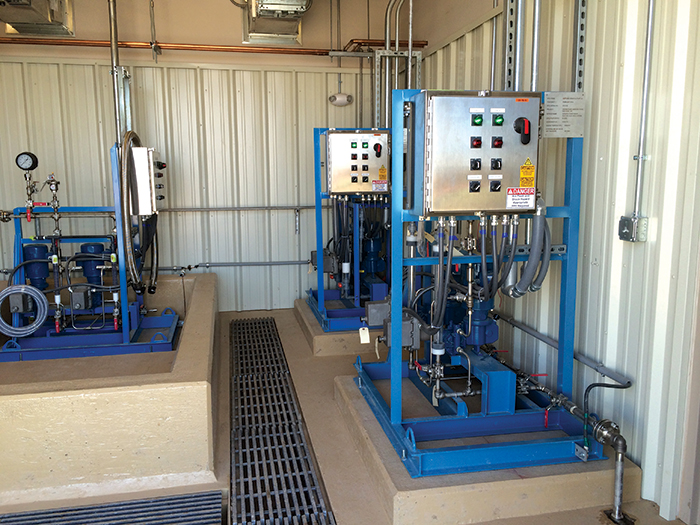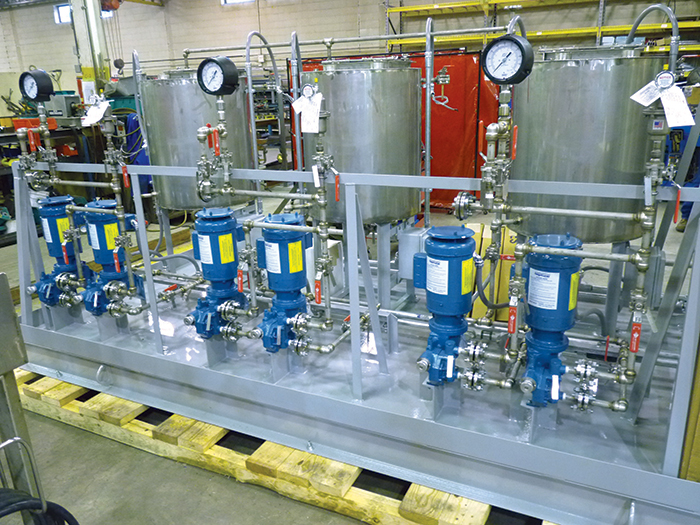Four main technologies are available, and plant operators can optimize operations by selecting the best combination of these options.
At first glance, the treatment of municipal wastewater may seem straightforward. Fouled water flows through a wastewater treatment facility, where harmful impurities or particulates are removed. Once the water has reached a predetermined level of cleanliness, it is either released to the environment or sent for reuse.
In reality, treating wastewater is a complicated process involving critical steps that must be performed to exact criteria by highly technical equipment. The system is only effective when the proper chemicals are used to treat the water, and these chemicals can cover a wide range of pH levels, viscosities, material compatibilities and handling characteristics.
A few of the more commonly used chemicals in wastewater treatment applications and their characteristics are outlined below.

Image 1. Peristaltic pumps are ideal for various chemical-handling applications in wastewater treatment because their simplistic design and operation allow them to reliably handle both viscous and abrasive chemicals. (Images courtesy of Neptune Chemical Pump, part of PSG, a Dover Company)
- Sodium hypochlorite: Widely known as bleach, this liquid is most commonly used for disinfection at the treatment plant. This chemical is one of the most difficult to handle because it corrodes most metals it comes in contact with, and it cannot be mixed or stored with ammonia or other acids, organics and reducing agents used at the plant. It is also difficult because of its tendency to off-gas, which can cause metering pumps to become gas-bound. To prevent this, special vent valves are available for diaphragm pumps. Peristaltic pumps, which do not allow this phenomenon to occur, also can be used.
- Sulfuric acid: Used for pH adjustment, this chemical is provided either as a concentrate or dilute. Concentrated solutions can be handled in many situations with cast iron, steel materials or Alloy 20, while dilute solutions require plastics such as PVC or Kynar.
- Sodium hydroxide: Also used for pH adjustment, this chemical is often provided in solution strengths from 25 to 50 percent. Metering pump elastomers, such as Viton (a material often used for O-ring seals within a metering pump), are not compatible with sodium hydroxide, so they require special care. Especially in higher solution strengths, this chemical tends to gel in the pump if the pump is idle for a period of time. Flush valves or special pump heads can assist with this issue.
- Sodium bisulfite: This is one of the most commonly used dechlorinating agents at treatment plants. A mixer is usually required to keep this chemical in solution in the metering pump supply tank. Suitable materials for this chemical include plastics, such as PVC and Kynar, and metals, such as 316 stainless steel.
- Emulsion polymer: Fed as a coagulant to assist the dewatering equipment within a wastewater treatment facility, this chemical is shear-sensitive once hydrated and is often extremely viscous. Diaphragm pumps with high-viscosity head designs or peristaltic pumps are often required.
Faced with a myriad of chemicals that have unique handling and implementation characteristics, plant operators must be certain that they have selected the proper metering pump technologies for their dosing applications.
Because there is no “one-size-fits-all” solution, creating the most efficient, effective and safe chemical-handling operation in wastewater treatment likely requires the use of different types of pump technologies, all of which bring their own set of benefits to the operation.
Outlined below are four pump technologies that, if implemented properly, can play a key role in an optimized wastewater treatment operation.
1. Mechanical Diaphragm Metering Pumps
Mechanically actuated diaphragm metering pumps are easy to implement and operate, which makes them an attractive alternative for many applications. They typically have a lower initial cost than other motor-driven metering pump designs, especially at higher flow rates, but they can have higher operating costs.
Because the diaphragm is attached to the piston for a positive return usually aided by a spring, these pumps offer excellent suction-lift capabilities and can handle liquids that off-gas, such as sodium hypochlorite, and more viscous chemicals.
These pumps are somewhat limited in discharge pressure capabilities, with many being around 100 to 150 pounds per square inch (psi) (7 to 10 bar) max. Repeatable accuracy is typically about +/-2 percent.
They are generally not offered with an on-board relief valve, so an external relief valve is usually required to prevent damage to the pump in an over-pressurized situation.

Image 2. Hydraulically actuated diaphragm metering pumps are a technology of choice for many wastewater treatment plants because they can handle the hardest chemicals, can pump against higher pressures, offer highly repeatable dosing accuracy and have been designed for 20 years of service.
2. Hydraulic Diaphragm Metering Pumps
As a low-maintenance pump designed for 20 years of service, hydraulically actuated diaphragm metering pumps are ideal for operation in the harshest chemical-handling conditions. Their longevity and minimal maintenance requirements are possible because most of their moving parts are submerged in a bath of hydraulic fluid and because the diaphragm is hydraulically balanced.
Hydraulically balanced means that the hydraulic fluid is on the oil side of the diaphragm, while the chemical being pumped is on the other side (wetted or process side) of the diaphragm. The piston, internal to the pump, pushes oil against the diaphragm but never comes in direct contact with it. These pumps are capable of pumping against extremely high pressures, so long discharge lines are not a problem.
Hydraulic diaphragm pumps are equipped with an adjustable internal relief valve that prevents an over-pressurized situation, which could damage the pump. They also offer a repeatable dosing accuracy of +/-1 percent.

Image 4. Because many pump manufacturers also design the other components that make up a complete chemical-feed system, they can be a significant source of assistance, or even a provider of comprehensive turnkey systems, for wastewater-handling operations.
3. Solenoid Diaphragm Metering Pumps
Solenoid-actuated, or electronic, metering pumps are an economical option in wastewater treatment operations for low-flow/low-pressure chemical-dosing applications. They are generally available to a maximum of 20 gallons per hour (gph) (76 liters per hour). At those capacities, maximum pressures are about 30 psi (2 bar).
The lower and medium capacities are compatible with pressures of 100 to 150 psi with low flows (less than 1 gph) to more than 200 psi (14 bar). They offer a repeatable dosing accuracy of +/-3 percent. They are normally provided with an on-board relief valve to prevent pump damage resulting from over-pressurization.
4. Peristaltic Pumps
This pump technology, simplistic in its design, is well-suited for handling viscous and abrasive chemicals. Because the design features a rotor with shoes or rollers that squeeze the hose or tube and force the liquid to the discharge port, peristaltic pumps are able to run dry—a feature that technologies like some progressive cavity pumps cannot provide because their rotors and stators may be damaged in dry-run conditions.
Peristaltic pumps also do not have valves that can become clogged. This is an important consideration when the pump needs to be shut down during a product run. The lack of valves in a peristaltic pump eliminates any clogging issues, especially when handling viscous liquids or those that will solidify or become gelatinous when resting. This also makes the peristaltic pump ideal for handling abrasive or corrosive chemicals.
Help from Manufacturers
While these pump technologies can provide a list of benefits for wastewater treatment plant operators, the challenge is knowing which pump is best for which chemical-metering application. This is where the pump manufacturer can lend a hand.
Many pump manufacturers also design and manufacture many of the components that are included in a complete chemical-feed system; for example, relief and backpressure valves, calibration columns, tanks, mixers, injection quills, and control panels.
Some offer the complete chemical-feed system as an option and can build a system that meets the specific needs of the treatment plant. While the task of properly outfitting a treatment facility may be overwhelming, manufacturers of the various components that will be used to optimize the system, or the manufacturer of a complete system, can assist in determining how to best outfit the plant.
Optimizing Operation
Ensuring that communities have the cleanest water possible places a great amount of pressure on water and wastewater treatment facilities to perform their jobs as effectively, efficiently and safely as possible. The various chemicals that may be required in the different treatment processes only increase the plant operator’s risk.
An operation will reach the pinnacle of proper performance only if the best pump technologies are chosen for each of the many critical chemical-metering processes.
ABOUT THE AUTHOR
Tom O’Donnell is director of business development for Neptune Chemical Pump Company and PSG. He may be reached at 215-699-8700, ext. 3327, or tom.odonnell@psgdover.com. Neptune is a manufacturer of chemical metering and peristaltic (hose) pumps, chemical feed systems, chemical injection accessories, polymer make-down systems and industrial mixers. Neptune is a product brand of PSG, a Dover company. For more information, visit neptune1.com and psgdover.com.